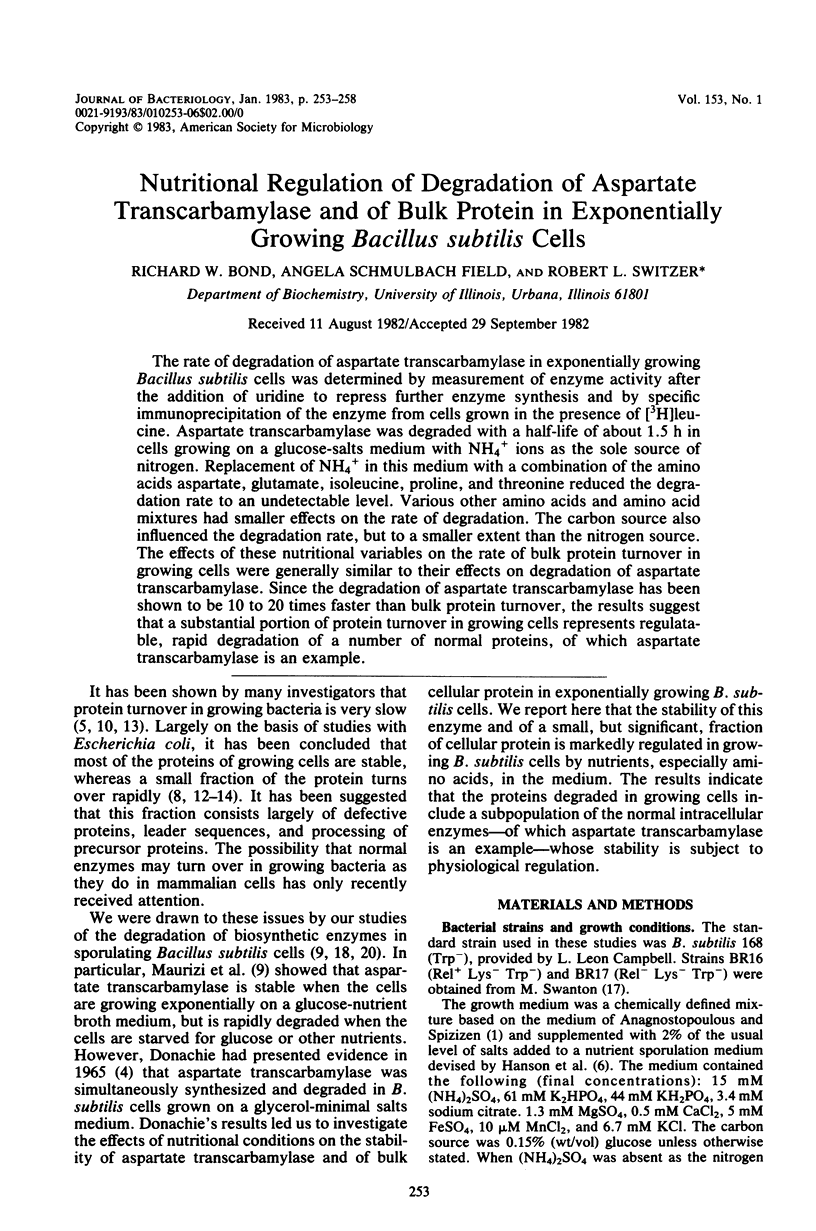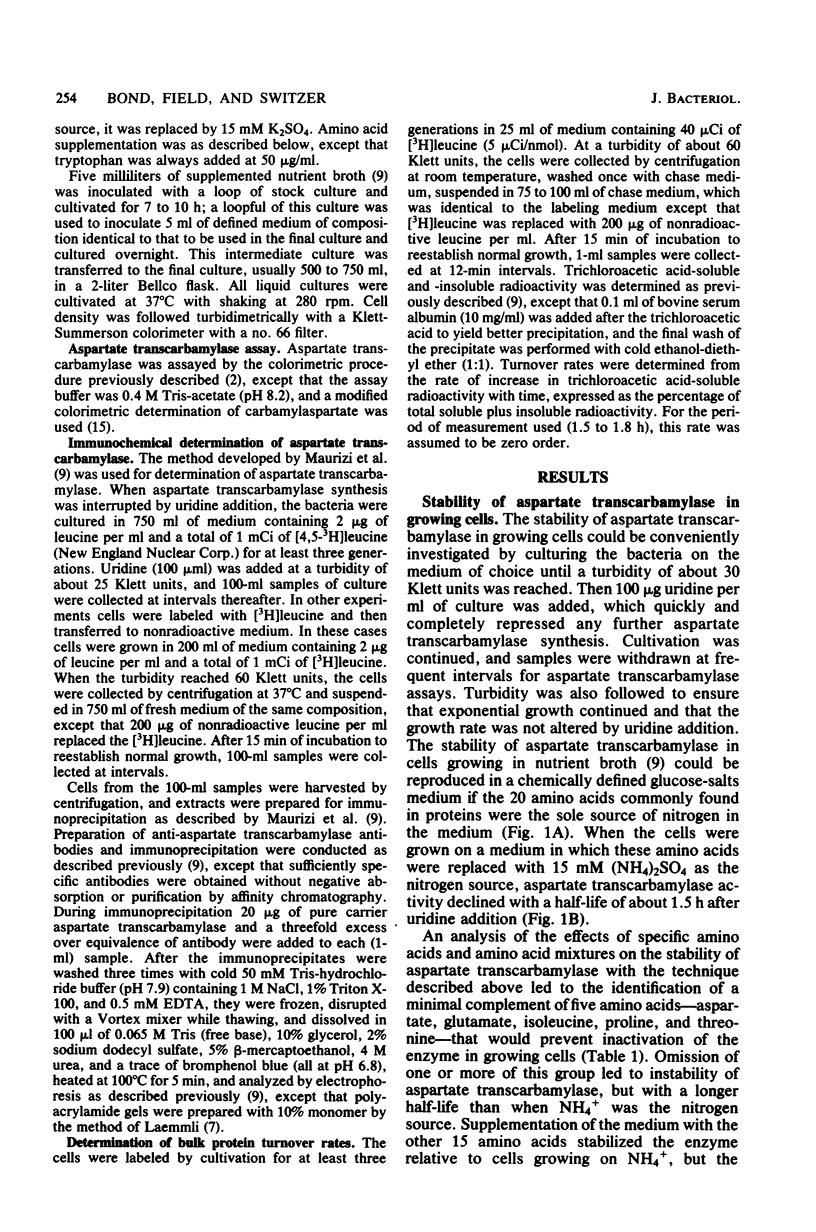Abstract
The rate of degradation of aspartate transcarbamylase in exponentially growing Bacillus subtilis cells was determined by measurement of enzyme activity after the addition of uridine to repress further enzyme synthesis and by specific immunoprecipitation of the enzyme from cells grown in the presence of [3H]leucine. Aspartate transcarbamylase was degraded with a half-life of about 1.5 h in cells growing on a glucose-salts medium with NH4+ ions as the sole source of nitrogen. Replacement of NH4+ in this medium with a combination of the amino acids aspartate, glutamate, isoleucine, proline, and threonine reduced the degradation rate to an undetectable level. Various other amino acids and amino acid mixtures had smaller effects on the rate of degradation. The carbon source also influenced the degradation rate, but to a smaller extent than the nitrogen source. The effects of these nutritional variables on the rate of bulk protein turnover in growing cells were generally similar to their effects on degradation of aspartate transcarbamylase. Since the degradation of aspartate transcarbamylase has been shown to be 10 to 20 times faster than bulk protein turnover, the results suggest that a substantial portion of protein turnover in growing cells represents regulable, rapid degradation of a number of normal proteins, of which aspartate transcarbamylase is an example.
Full text
PDF





Selected References
These references are in PubMed. This may not be the complete list of references from this article.
- Anagnostopoulos C., Spizizen J. REQUIREMENTS FOR TRANSFORMATION IN BACILLUS SUBTILIS. J Bacteriol. 1961 May;81(5):741–746. doi: 10.1128/jb.81.5.741-746.1961. [DOI] [PMC free article] [PubMed] [Google Scholar]
- Brabson J. S., Switzer R. L. Purification and properties of Bacillus subtilis aspartate transcarbamylase. J Biol Chem. 1975 Nov 25;250(22):8664–8669. [PubMed] [Google Scholar]
- Chaloupka J., Krecková P. Regulation of the formation of protease in Bacillus megaterium. I. The influence of amino acids on the enzyme formation. Folia Microbiol (Praha) 1966;11(2):82–88. doi: 10.1007/BF02878835. [DOI] [PubMed] [Google Scholar]
- Donachie W. D. Control of enzyme steps during the bacterial cell cycle. Nature. 1965 Mar 13;205(976):1084–1086. doi: 10.1038/2051084a0. [DOI] [PubMed] [Google Scholar]
- Goldberg A. L., St John A. C. Intracellular protein degradation in mammalian and bacterial cells: Part 2. Annu Rev Biochem. 1976;45:747–803. doi: 10.1146/annurev.bi.45.070176.003531. [DOI] [PubMed] [Google Scholar]
- Laemmli U. K. Cleavage of structural proteins during the assembly of the head of bacteriophage T4. Nature. 1970 Aug 15;227(5259):680–685. doi: 10.1038/227680a0. [DOI] [PubMed] [Google Scholar]
- Larrabee K. L., Phillips J. O., Williams G. J., Larrabee A. R. The relative rates of protein synthesis and degradation in a growing culture of Escherichia coli. J Biol Chem. 1980 May 10;255(9):4125–4130. [PubMed] [Google Scholar]
- Maurizi M. R., Brabson J. S., Switzer R. L. Immunochemical studies of the inactivation of aspartate transcarbamylase by stationary phase Bacillus subtilis cells. Evidence for selective, energy-dependent degradation. J Biol Chem. 1978 Aug 25;253(16):5585–5593. [PubMed] [Google Scholar]
- Maurizi M. R., Switzer R. L. Proteolysis in bacterial sporulation. Curr Top Cell Regul. 1980;16:163–224. doi: 10.1016/b978-0-12-152816-4.50010-8. [DOI] [PubMed] [Google Scholar]
- May B. K., Elliott W. H. Characteristics of extracellular protease formation by Bacillus subtilis and its control by amino acid repression. Biochim Biophys Acta. 1968 May 21;157(3):607–615. doi: 10.1016/0005-2787(68)90158-5. [DOI] [PubMed] [Google Scholar]
- Mosteller R. D., Goldstein R. V., Nishimoto K. R. Metabolism of individual proteins in exponentially growing Escherichia coli. J Biol Chem. 1980 Mar 25;255(6):2524–2532. [PubMed] [Google Scholar]
- Nath K., Koch A. L. Protein degradation in Escherichia coli. I. Measurement of rapidly and slowly decaying components. J Biol Chem. 1970 Jun 10;245(11):2889–2900. [PubMed] [Google Scholar]
- Pine M. J. Turnover of intracellular proteins. Annu Rev Microbiol. 1972;26:103–126. doi: 10.1146/annurev.mi.26.100172.000535. [DOI] [PubMed] [Google Scholar]
- Shindler D. B., Prescott L. M. Improvements on the Prescott-Jones method for the colorimetric analysis of ureido compounds. Anal Biochem. 1979 Sep 1;97(2):421–422. doi: 10.1016/0003-2697(79)90096-4. [DOI] [PubMed] [Google Scholar]
- St John A. C., Conklin K., Rosenthal E., Goldberg A. L. Further evidence for the involvement of charged tRNA and guanosine tetraphosphate in the control of protein degradation in Escherichia coli. J Biol Chem. 1978 Jun 10;253(11):3945–3951. [PubMed] [Google Scholar]
- Swanton M., Edlin G. Isolation and characterization of an RNA relaxed mutant of B. subtilis. Biochem Biophys Res Commun. 1972 Jan 31;46(2):583–588. doi: 10.1016/s0006-291x(72)80179-7. [DOI] [PubMed] [Google Scholar]
- Voellmy R., Goldberg A. L. Guanosine-5'-diphosphate-3'-diphosphate (ppGpp) and the regulation of protein breakdown in Escherichia coli. J Biol Chem. 1980 Feb 10;255(3):1008–1014. [PubMed] [Google Scholar]
- Waindle L. M., Switzer R. L. Inactivation of aspartic transcarbamylase in sporulating Bacillus subtilis: demonstration of a requirement for metabolic energy. J Bacteriol. 1973 May;114(2):517–527. doi: 10.1128/jb.114.2.517-527.1973. [DOI] [PMC free article] [PubMed] [Google Scholar]


